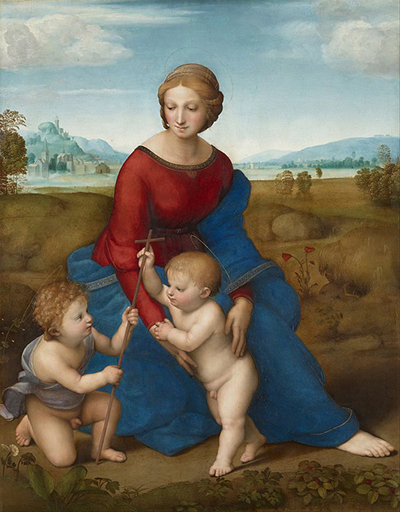Madonna del Prato (Madonna of the Meadow) is also known as Madonna del Belvedere due to it's long residence as part of the Imperial Collection at the Vienna Belvedere
Currently housed in the Kunsthistorisches Museum in Vienna. Painted in 1506 it depicts three figures the central one being that of the Virgin Mary as she looks down on the infants Jesus and John the Baptist.
She lovingly holds the toddler Jesus, propping him up as he leans towards the cross John is holding up in front of him.
Format and Symbolism
Placed centrally in the picture the protagonist fills the canvas with her left leg reaching diagonally to enhance the idea of her supporting Jesus. This leg and most of her body is draped in a rich blue, gold bordered mantle which is there to symbolise the Church.
This mantle covers a deep red dress depicting Christ's death, his blood and the two being on her unify Mother Church with Christ's sacrifice.
In the background behind the central figures three poppies bloom to represent Christ's passion, death and resurrection.
Madonna provided inspiration for huge numbers of artists in around the Renaissance era. You will find examples of her in almost every major artist, when religious themes were the most common route for artists to take. Some of the more significant Madonna paintings include Madonna of the Magnificat, Madonna and Child with St Anne, Madonna and Child with St Catherine and St Dominic and a Donor, Madonna of the Yarnwinder and Benois Madonna.
Composition
Raphael uses the now established pyramidal style of compositing this centrally placed scene which he picked up from Leonardo. Also inspired by Leonardo he paints the three figures using chiaroscuro, a bold use of contrasting light and shade to add real volume and depth while the landscape around and behind them is much softer.
With the use of aerial perspective typical with the era a real sense of enormous depth of the landscape is created. Raphael, unlike Leonardo chooses to us a lighter palette to give a softer feel. This can be seen to be much more in the style of his teacher, Perugino than of his contemporary.
The overall effect is of a much calmer un-challenging scene than we would see from Leonardo. The only slight challenge to the viewer is it showing the child Jesus grabbing at the cross John the Baptist holds hinting at en early prediction of the forthcoming Passion of Christ though the calm nature of the scene seem altogether much more innocent.
Her face slightly lifted as she looks down on the children ultimately is a reassurance of the mother's care, love and all seeing secure attention.




